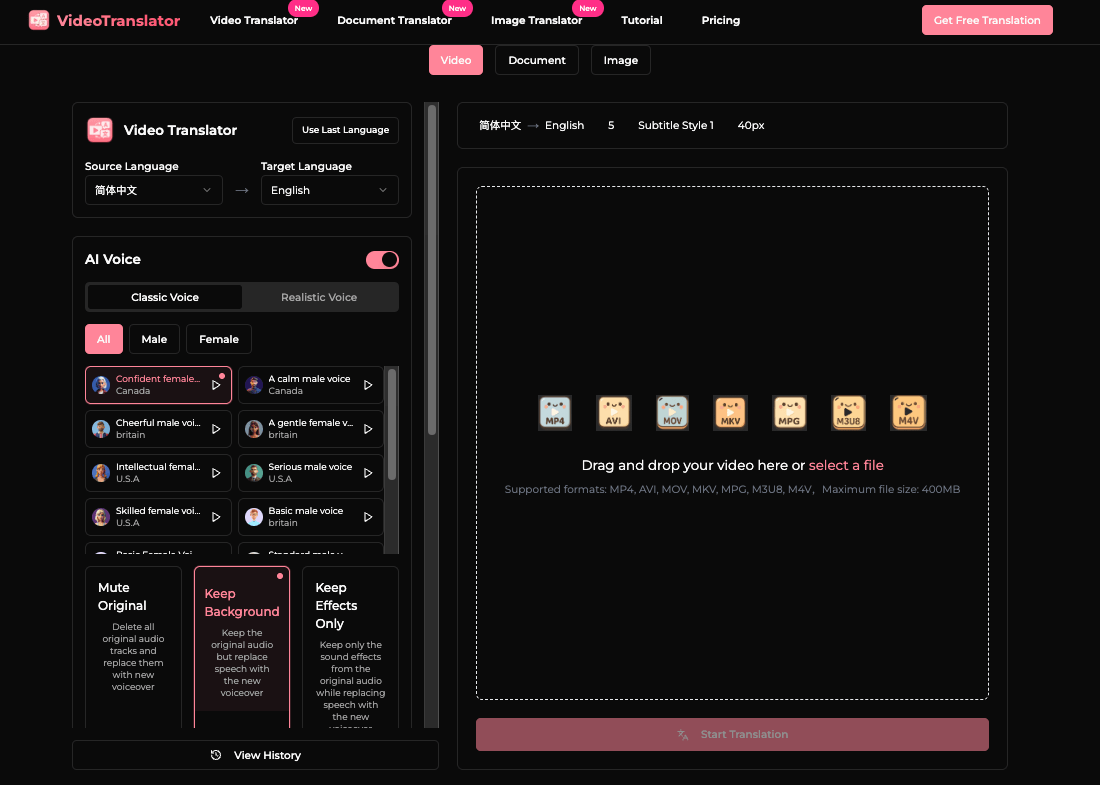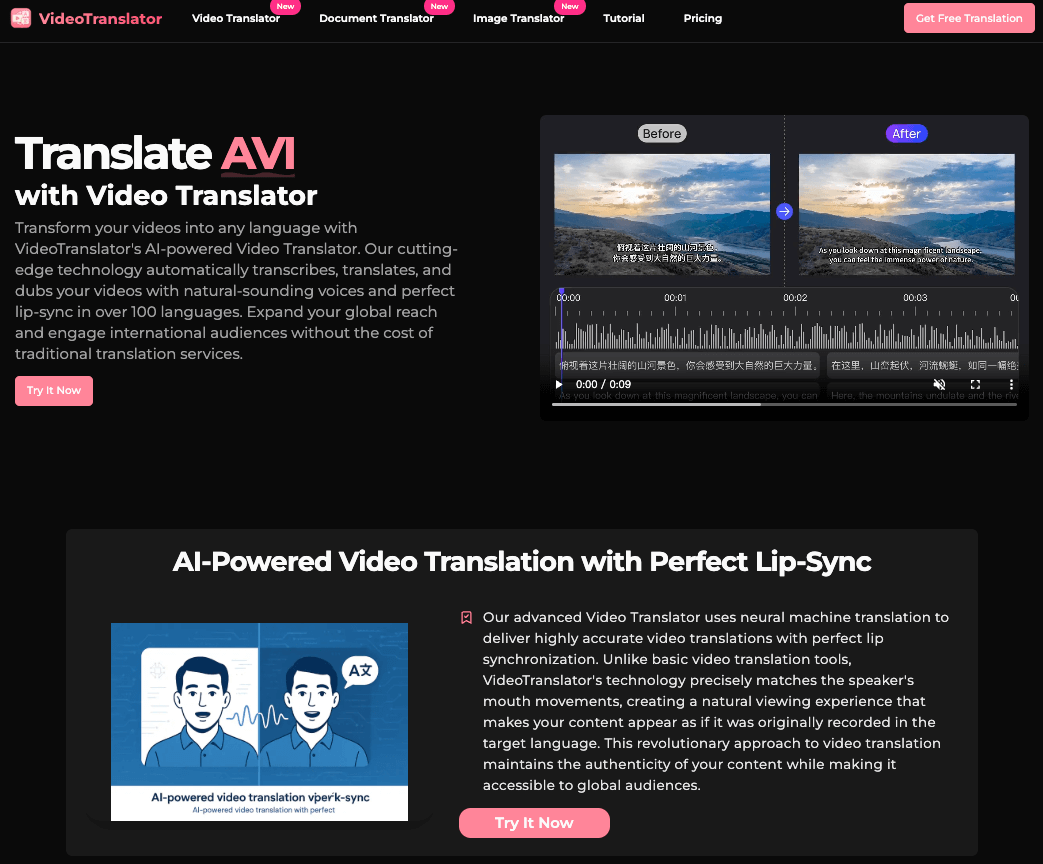What is Video Translation? (A Complete Guide)
In our interconnected digital world, video has become the primary medium for online communication. Yet, language barriers continue to restrict the potential reach and effectiveness of video content. Whether you're a content creator seeking to grow your audience, a business expanding into global markets, or an educator making learning materials available worldwide, video translation provides an essential solution. Research indicates that video content will represent more than 82% of all internet traffic in the near future, highlighting the critical importance of video translation capabilities.
What is Video Translation?
Video translation transforms video content from one language to another while maintaining the original meaning, emotional resonance, and stylistic elements. Going beyond basic subtitle generation, contemporary video translation employs a holistic approach that integrates speech-to-text conversion, language translation, subtitle creation, AI voice dubbing, and advanced lip-synchronization technology to deliver an authentic viewing experience in the target language.

Traditional video translation methods were time-consuming, expensive, and often resulted in awkward dubbing or distracting subtitles. However, with advancements in AI technology, video translation has been revolutionized, offering faster, more accurate, and natural-sounding results that maintain the original speaker's tone and personality.
How Video Translation Works
Modern AI-powered video translation platforms like VideoTranslator utilize several sophisticated technologies working together:
-
Speech Recognition: The system first transcribes the spoken content in the original video using automatic speech recognition (ASR) technology.
-
Neural Machine Translation: The transcribed text is then translated into the target language using neural machine translation (NMT), which understands context and semantics for more natural translations.
-
Text-to-Speech Synthesis: For dubbing, AI voice generators create natural-sounding speech in the target language, often with the ability to clone the original speaker's voice characteristics. If you need only voice translation without video, you can use Voice Translator for quick audio conversions.
-
Lip-Syncing Technology: Advanced systems synchronize the new audio with the speaker's lip movements, creating a more authentic and engaging viewing experience.
-
Subtitle Generation: The platform can also generate customizable subtitles in the target language with various style options. For standalone subtitle creation, Subtitle Translator offers specialized tools for this purpose.
This entire process, which once took days or weeks with human translators, can now be completed in minutes with AI technology while maintaining high quality and natural results.
Benefits of AI Video Translation
Implementing video translation offers numerous advantages for different users:
For Content Creators:
- Expanded Global Reach: Access new audiences and markets by removing language barriers
- Increased Engagement: Native-language content leads to higher viewer retention and interaction
- Cost-Effective: AI translation is significantly less expensive than traditional dubbing services
- Time-Saving: Translate hours of content in minutes rather than days or weeks
For Businesses:
- Market Expansion: Enter new international markets with localized video content
- Improved Conversion Rates: 72.4% of consumers are more likely to buy products when information is available in their language
- Enhanced Training: Create multilingual training materials for global teams
- Consistent Brand Voice: Maintain your brand's tone and personality across all languages
For Educational Institutions:
- Global Accessibility: Make educational content available to students worldwide
- Improved Learning Outcomes: Students comprehend better in their native language
- Inclusive Education: Support diverse student populations with multilingual resources
Types of Video Translation
There are several approaches to video translation, each with specific use cases:
-
Subtitle Translation: Adding translated text at the bottom of the screen. This is the simplest method but requires viewers to read while watching. For dedicated subtitle needs, try Subtitle Translator for efficient subtitle generation in multiple languages.
-
Dubbing with AI Voices: Replacing the original audio track with translated speech. Modern AI voices sound increasingly natural and can maintain the emotional nuances of the original. The Voice Translator tool can be used independently for pure audio translation needs.
-
Voice Cloning Translation: Using AI to replicate the original speaker's voice in the target language, creating a more authentic experience.
-
Lip-Synced Dubbing: Synchronizing the translated audio with the speaker's lip movements for a seamless viewing experience that appears as if the content was originally created in the target language.
Each approach has its advantages, and the best choice depends on your specific needs, audience preferences, and content type.
How to Translate a Video: Step-by-Step Tutorial
Translating your videos with VideoTranslator is straightforward:

-
Upload Your Video: Upload your video file (supported formats include MP4, AVI, MOV, MKV, MPG, M3U8, and M4V).
-
Select Languages: Choose from 130+ languages and dialects for both source and target languages.
-
Customize AI Voice Options: Select from classic or realistic AI voices with different genders, ages, and tones. You can even preview the voices before selecting.
-
Configure Audio Settings: Choose to maintain original audio, keep background effects only, or mute the original audio completely.
-
Customize Subtitles: Select from 13 different subtitle styles and adjust size as needed. If you only need subtitles without changing the audio, consider using the dedicated Subtitle Translator tool.
-
Process Your Video: Click "Start Translation" and let the AI process your video.
-
Download and Share: Once complete, download your translated video or share it directly to social media platforms.
The entire process takes just minutes, depending on your video length, and provides professional-quality results that were previously only possible with expensive production studios.
Common Applications of Video Translation
Marketing and Advertising
Global brands use video translation to adapt advertising campaigns for different markets while maintaining consistent messaging. This allows for culturally relevant content that resonates with local audiences.
E-Learning and Education
Educational institutions and online learning platforms translate course videos to reach international students. This is particularly valuable for universities expanding their global presence and online course providers.
Entertainment and Content Creation
YouTubers, TikTok creators, and other content producers translate their videos to grow their international audience. Many creators have seen substantial subscriber growth after implementing video translation.
Corporate Communications
Multinational companies use video translation for internal communications, training materials, and product demonstrations to ensure all employees, regardless of location, receive consistent information.
Video Conferencing
Real-time video translation is becoming increasingly important for international meetings and conferences, allowing participants to communicate effectively despite language differences.
Frequently Asked Questions
How accurate is AI video translation?
Modern AI translation technology achieves over 95% accuracy for most common language pairs. However, technical terminology, idioms, and cultural references may still benefit from human review for perfect accuracy.
Which languages are supported?
Leading video translation tools support 130+ languages and dialects, including English, Spanish, Chinese, Hindi, Arabic, Japanese, Korean, Portuguese, French, German, Italian, Russian, and many others.
Can I translate a video with multiple speakers?
Yes, advanced video translation systems can identify different speakers and maintain their distinct voices in the translated version.
Does video translation affect video quality?
No, the visual quality of your video remains unchanged. Only the audio and subtitles are modified during the translation process.
How much does video translation cost?
Costs vary depending on the service provider, video length, and specific features required. AI-powered solutions are typically much more affordable than traditional translation and dubbing services.
What if I only need to translate the audio without video?
If you only need to translate audio files or voice recordings, you can use the specialized Voice Translator tool, which focuses exclusively on audio translation with the same high-quality AI technology.
Conclusion
Video translation has evolved from a luxury to a necessity in our increasingly connected world. With AI-powered tools like VideoTranslator, creating multilingual video content is now accessible to everyone, from individual content creators to large enterprises. By implementing video translation, you can dramatically expand your reach, engage diverse audiences, and communicate your message effectively across language barriers.
As video content continues to dominate online communication, the ability to translate videos quickly and accurately will become increasingly valuable. Start exploring video translation today to stay ahead of the curve and connect with your global audience in their preferred language.
For other types of translation needs, consider trying Document Translator for translating text documents, Image Translator for translating text within images, Subtitle Translator for subtitle-only translations, or Voice Translator for audio-only translations.